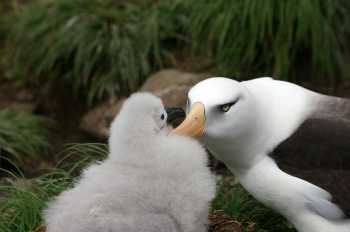Paul Sagar (National Institute of Water and Atmospheric Research, New Zealand) reported earlier this year to the Department of Conservation’s Conservation Services Programme on population estimates of Grey-headed Thalassarche chrysostoma and Campbell T. impavida Albatrosses at Campbell Island.
The report’s executive summary follows:
“Counts of nests in photographs taken during the period 2006-2012 were compared to those reported for the period 1940s to 1997 by Moore (2004) for grey-headed albatross (Thalassarche chrysostoma) and Campbell albatross (T. impavida) at Campbell Island. Photographs of known colonies were taken from established long-term photopoints during late October and early November in both 2011 and 2012. Following downloading to a PC the numbers of apparent occupied nests in specific count areas described in detail by Moore & Blezard (1999) were counted and added to a spreadsheet of counts provided by the Department of Conservation. Trends in the numbers of the two species of albatross were analysed using the TRIM software, with data inputted separately for colonies dominated by grey-headed albatrosses and Campbell albatrosses.
The results indicated uncertain trends for both species for the period 1995-97 to 2006-2012, with estimated numbers of grey-headed albatrosses showing a non-significant increase and those of Campbell albatrosses a non-significant decrease. However, with counts in just 1-2 years during the period 2006-2012 and grey-headed albatross being a biennial-breeding species it is probably prudent not to put too great a confidence in the trends until more data are recorded.
Assuming that the proportions of each species have remained similar to those estimated in 1995-97 at all colonies then the total number of annual breeding pairs of grey-headed albatross was estimated at 8,611 pairs and that of Campbell albatrosses at 21,648 pairs for the period 2006-2012.”

A Campbell Albatross preens its chick, photograph by David Evans
Reference:
Sagar, P. 2014. Population estimates and trends of Campbell and grey-headed albatrosses at Campbell Island. Christchurch: National Institute of Water and Atmospheric Research Ltd. 28 pp.
John Cooper, ACAP Information Officer, 13 August 2014

 English
English  Français
Français  Español
Español